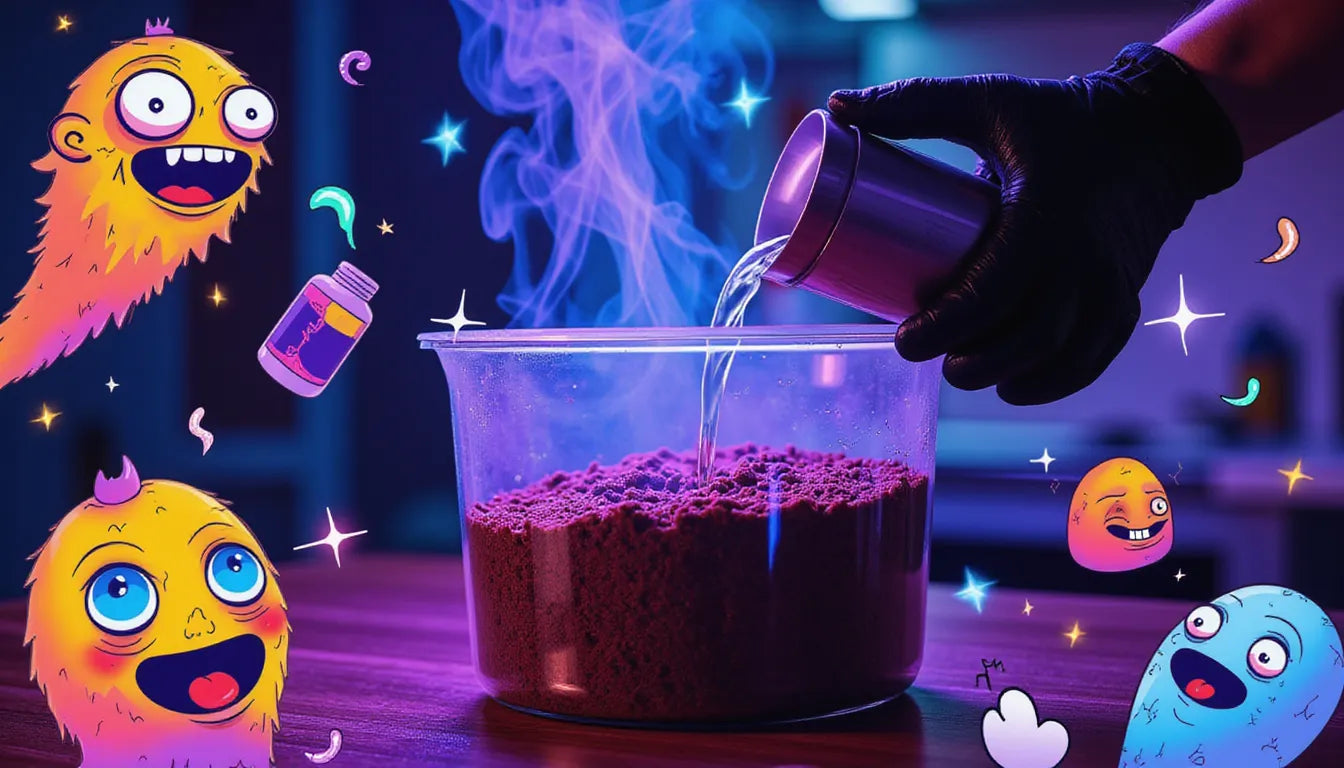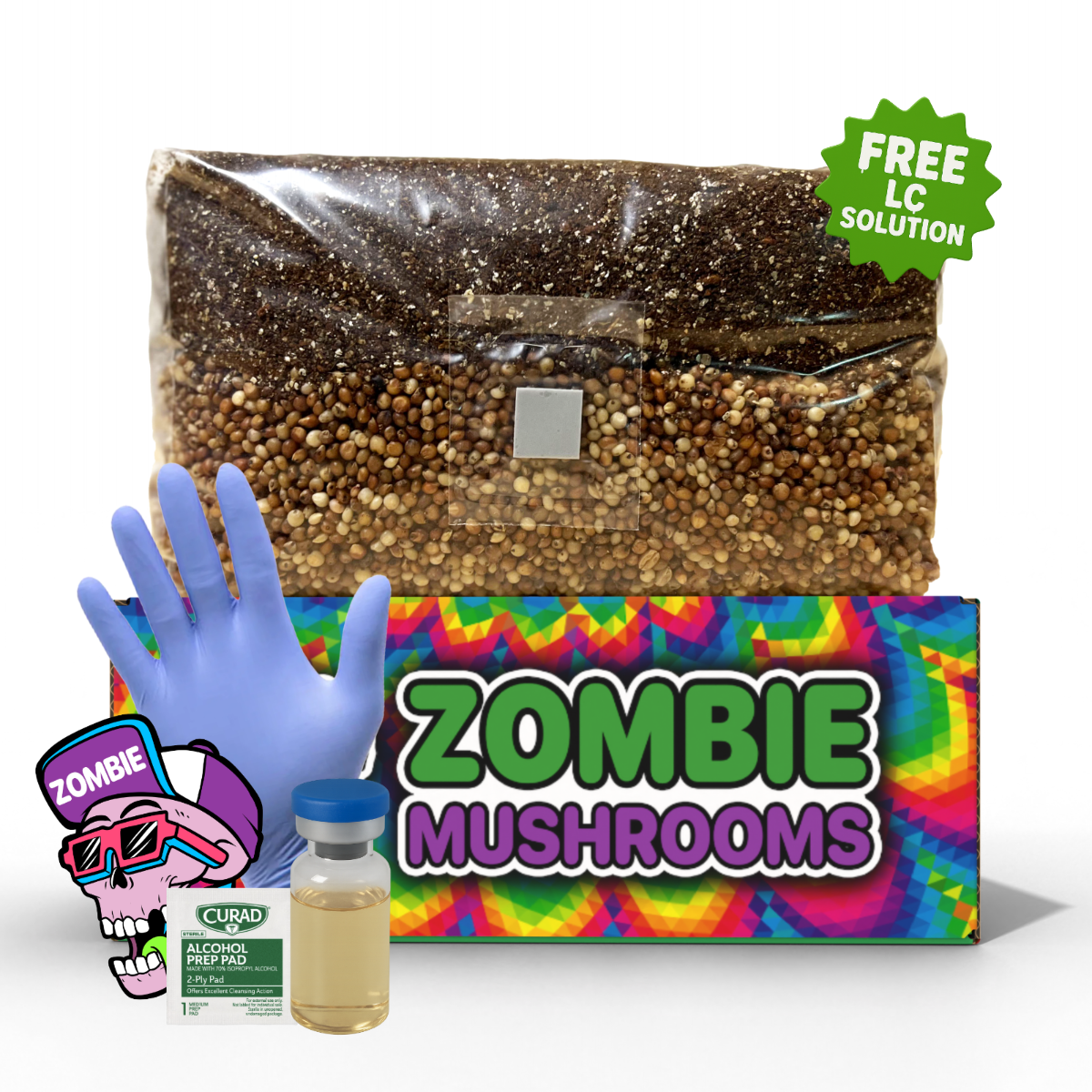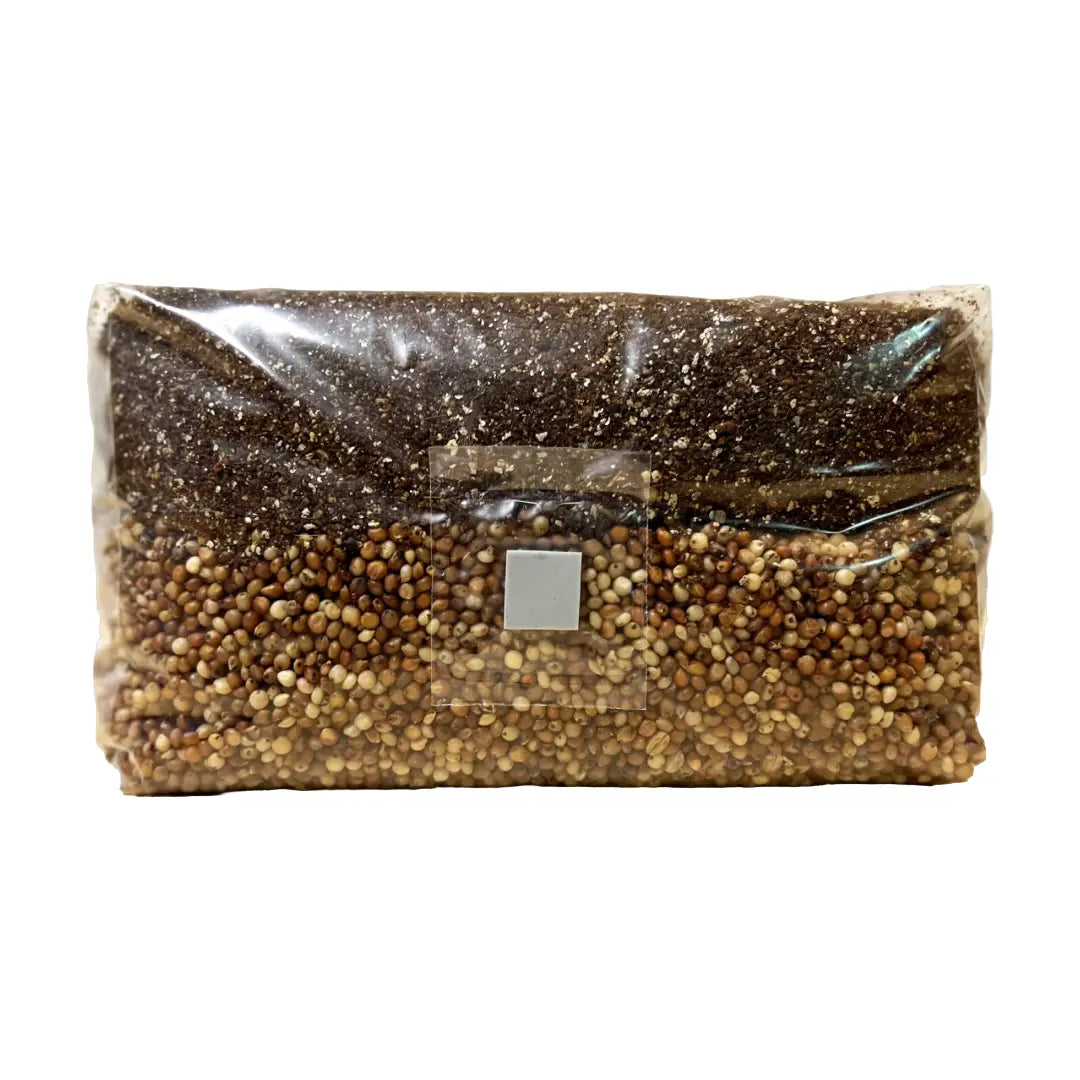⬇️ Prefer to listen instead? ⬇️

- 🌱 Coco coir’s natural structure and anti-contaminant properties make it good for mushroom cultivation.
- ⏱️ CVG substrates lead to 20% faster colonization rates compared to straw and wood chip mixes.
- 🔥 Pasteurization, not sterilization, is typically enough for safe CVG preparation.
- 🧪 Field capacity impacts growth speed and contamination risk; the right moisture balance is important.
- 🧂 Adding gypsum improves pH buffering and mineral availability, helping mycelial health.

What is Coco Coir and Why It's Valuable in Mushroom Cultivation
Coco coir substrate has become popular for its sustainability and how well it works in biology and farming. It comes from the fibrous husk around a coconut’s inner shell. Coco coir is often a byproduct, discarded when coconuts are harvested. But what was once waste material is now seen as an eco-friendly option for many growing settings, especially for mushrooms.
Here's why coco coir is a good base for mushroom substrate:
- Good moisture retention: Coco coir holds a lot of water for its weight, just like a sponge. This makes sure mushroom mycelium always has water during colonization and fruiting.
- Good aeration: Its fibrous makeup creates air pockets. This stops the substrate from getting packed down, keeping it loose and breathable. And this is important for mycelium, which needs oxygen.
- Resists contaminants: Coco coir resists bacterial and mold contamination naturally because it has high lignin and cellulose. This gives mushroom growers better results, even without laboratory-standard sterilization [(Barron, 2021)].
Coco coir also has a nearly neutral pH, from 5.5 to 6.8. This makes it work with many mushroom species.

Breaking Down CVG: Coco Coir, Vermiculite, and Gypsum
CVG substrate is made of three things—coco coir, vermiculite, and gypsum. It is a good mix for mushroom growth.
🥥 Coco Coir
As said before, this part makes up most of the CVG substrate. Besides structure and moisture control, coco coir breaks down slowly. This lets it give a long-lasting base for growth through many flushes.
🪨 Vermiculite
Vermiculite is a hydrated magnesium-aluminum-iron silicate. It expands when heated, making it act like a sponge. It improves moisture retention and helps make the substrate balanced. The mineral's porous nature holds water and slowly releases it, giving steady water for several days.
- It also adds bulk and surface area to the substrate.
- And it helps stop drying out during the fruiting cycle.
- It is not toxic and does not react chemically.
🧂 Gypsum (Calcium Sulfate)
Gypsum is often missed, but it adds nutrients and helps keep the pH steady. This mineral adds calcium and sulfur to the substrate. These are two micronutrients that help fungi grow.
- It helps stop clumping and compaction.
- It keeps the pH steady and stops it from becoming too acidic.
- It improves enzyme performance in mycelial colonization.
Together, these three ingredients form a versatile and good mushroom cultivation substrate. It works for both hobbyists and professionals.

Why CVG Is a Top Choice for Mushroom Cultivation
People like the CVG blend not just because it's easy to make, but also because it helps fungi grow well. This mix gives good results that are hard to beat:
🚀 1. Faster Colonization and Fruiting
A study found that substrates like CVG made mycelium colonize up to 20% faster than other mixes like straw and wood chips [(Jameson & Nguyen, 2020)]. Faster colonization means less time for contamination to happen, making success more likely.
🌍 2. Broad Mushroom Compatibility
CVG works well as a mushroom substrate for:
- Psilocybe cubensis
- Oyster mushroom species (Pleurotus ostreatus)
- Lion’s Mane (Hericium erinaceus)
- Reishi (Ganoderma lucidum) when supplemented
Each mushroom needs different food and growing conditions. But CVG can be changed to fit specific species. You can alter moisture, quantity, or add more materials like sawdust or manure for wood-loving fungi.
⚙️ 3. Easy to Work With
Making CVG substrate is simple. You don't need sterile rooms to start. And it works for small or large grows.
🛡️ 4. Adds Structural Integrity
Unlike straw or manure, which break down fast or clump, CVG keeps its shape. This means there's always air and food for mycelium through many flushes.

Step-by-Step: How to Make CVG Mushroom Substrate at Home
Making a CVG mushroom substrate at home needs basic tools and ingredients. Follow this guide to make a substrate that works well and resists contamination. It is good for most species.
Ingredients:
- 650g compressed coco coir brick
- 2 quarts vermiculite
- 1 cup gypsum (available online or at gardening centers)
- 4–5 quarts boiling water
- 5-gallon food-grade bucket with lid, or mixing tub with foil covering
Preparation Steps:
- Hydration: Put the coir brick in your bucket. Carefully pour the boiling water over it to make it expand. This step also pasteurizes the substrate at the same time.
- Cover and wait: Seal the bucket with its lid. Let it cool and expand naturally for 30–60 minutes.
- Fluffing and mixing: Open the bucket. Make sure the coir has water evenly. Start fluffing with clean hands or a sterilized tool.
- Add vermiculite and gypsum: Sprinkle in the measured amounts. Mix well, making sure no dry clumps are left.
- Test field capacity: The most important sign of a ready substrate is how moist it is. Your mix should release only 1–2 drops when you squeeze it firmly [(Smith, 2022)].
Once field capacity is reached and all materials are mixed well, your substrate is ready for inoculation.

CVG Substrate in Action: Matching Substrate to Mushroom Species
CVG is a general mushroom substrate. But small changes can make it better for each species.
| Mushroom | CVG Compatibility | Potential Tweaks |
|---|---|---|
| Psilocybe cubensis | Excellent | No changes needed |
| Oyster Mushrooms | Good | Add chopped straw (50/50 mix) |
| Lion’s Mane | Moderate | Reduce vermiculite by 25% |
| Reishi | Moderate | Mix with hardwood sawdust (70/30 mix) |
In each case, CVG gives a basic balance of moisture, air, and food. You only need small ingredient changes for specific needs.

The Science of Field Capacity: Measuring Moisture Content
Field capacity plays a big part in growth. Moisture affects not just how fast colonization happens, but also if unwanted bacteria or mold spores find a way in.
How to Measure:
- Take a firm handful of your mixed CVG.
- Squeeze hard over a clean surface.
- A few drops (1–2) mean it has enough water.
- A small stream means it's too wet.
- Crumbly or dry means it needs more water.
Field capacity makes sure the substrate gets oxygen and stays hydrated. Mycelium grows well with this balance.

Pasteurization vs. Sterilization: Treating Substrate Safely
When you make CVG mushroom substrates, pasteurization is better than sterilization for these reasons:
- It keeps good microbes, making it harder for bad things (like mold) to take over.
- It is more forgiving in open settings compared to sterilization, which kills everything.
- It reduces contamination risk when you are not working in a HEPA-filtered cleanroom [(Miller & Lao, 2019)].
Common Pasteurization Techniques:
- Bucket Tek: Just pour boiling water over your coco coir. Then let it sit sealed.
- Water Bath: Put substrate-filled bags into a 150°F water bath for one hour.
- Oven Pasteurization (less common): Bake substrate in oven bags inside a roasting pan with water at ~160°F.
Do not fully sterilize unless you are working in a lab-grade cleanroom.

Common Pitfalls in Preparing CVG Substrate
Mistakes in preparing substrate are a main reason for failed grows.
Top Issues:
- Too much water: This creates still areas, inviting bacteria and green mold.
- Uneven mixing: Moisture and nutrients can be uneven, causing patchy colonization.
- Dirty handling: Getting contaminants in with unclean hands or tools is a common beginner error.
Avoid these by using clean methods, wearing gloves, and keeping your prep area tidy.
Tools to Simplify CVG Prep: CVG Recipe Calculators and Kits
Making a lot of substrate, or even your first batch, can feel hard. But modern tools make it easier:
- CVG Calculators: Put in your grow container’s size to get exact amounts of coir, vermiculite, gypsum, and water.
- Pre-measured CVG kits: You can get these from specialty suppliers like Zombie Mushrooms. These kits have everything in the right amounts. This saves time and makes sure things are consistent.
These tools help reduce mistakes. They are good for first-time growers or hobbyists making many tubs.

Alternatives to CVG Substrate: How CVG Compares to Other Substrates
CVG is used widely. But sometimes other materials are better, depending on cost, species, or what's available nearby.
| Substrate | Pros | Cons |
|---|---|---|
| Straw | Easy to find, fast colonization | Breaks down fast |
| Sawdust | Good for wood-loving mushrooms | Needs sterilization |
| BRF Cakes | Great for beginners, small setup | Limited yields, not for large grows |
| Manure Mixes | High nutrient value | High contamination risk, messy to prep |
Compared to these, CVG is easy to use, can be used in many ways, and gives good results for most mushroom species.

Troubleshooting Substrate Failures: Mold, Stalling, and Under-Colonization
If you have problems during or after colonization, here’s a checklist to help find the issue:
- Green/black/blue mold: This means contamination. Throw out the substrate right away.
- Slow or halted growth: This is usually from low-quality spawn, not enough moisture, or contamination.
- Patchy colonization: This happens from uneven moisture or mixing.
If contamination is in a small area, separating it might help. For widespread problems, start with a fresh batch.
Using Grain Spawn with CVG: The Ideal Cultivation Pairing
CVG works best with grain spawn. Think of grain as mycelial seed stock, and CVG as productive soil. Together, they make colonization faster and improve fruiting.
- Good grain types: Rye berries, millet, sorghum, and wild bird seed.
- Grain gives a lot of initial nutrients.
- CVG expands growth and helps fruiting structures.
This pairing is standard for experienced growers doing large grows.
Final Thoughts: Building the Foundation for Successful Mushroom Growth
In mushroom cultivation, your substrate is everything. CVG—coco coir, vermiculite, and gypsum—gives good performance, reliability, and is easy to use. It's forgiving and has a low risk of contamination. So, it's no surprise many growers call it their go-to mushroom cultivation substrate. Whether you're just starting out or want to improve large production, CVG is a strong, lasting base. Pair it with healthy grain spawn, watch moisture carefully, and follow clean prep steps. Then you can get many flushes of healthy, strong mushrooms.
Ready to get going? Check out Zombie Mushrooms for pre-portioned kits, coco coir bricks, spawn, and more. This makes growing simpler than ever.
Citations
- Barron, C. (2021). The Benefits of Coco Coir as a Growing Medium. Hydroponics World Journal, 5(3), 142–149.
- Jameson, L., & Nguyen, T. (2020). Comparative Study of Bulk Substrates for Fungal Growth. Mycology and Agricultural Sciences, 12(2), 101–117.
- Smith, R. (2022). Understanding Field Capacity in Organic Substrates. Soil & Substrate Science Review, 8(1), 55–64.
- Miller, K., & Lao, D. (2019). Safe Preparation Techniques in Fungal Cultivation. Journal of Mycological Education, 7(4), 223–231.



